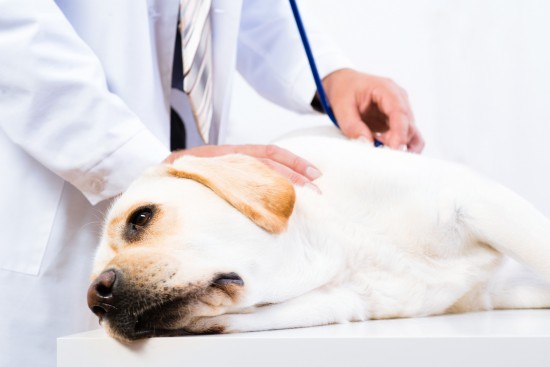Acute renal failure or ARF is characterized by a rapid onset of renal insufficiency/failure, reduction in glomerular filtration rate and renal plasma flow, and the clinical and biochemical aftermath of the excretory failure. This is a serious form of kidney disease where the dog's kidney quit working all of a sudden and that can leads to death. The kidneys have an abrupt decrease in the GFR due to a toxin or loss of adequate blood supply (called ischemia). The excretory failure is identified by rapid (hours to days) increases in BUN, serum creatinine and phosphate, and variable hyperkalemia and metabolic acidosis. Acute renal failure is a tenuously reversible state, which must be diagnosed quickly and aggressively treated. Failure to initiate therapy may result in irreversible parenchymal damage or death. Acute renal failure is frequently a complication of other surgical or medical diseases and must be recognized within the clinical features of these associated disorders.
Common clinical signs of kidney failures in dogs are loss of appetite, depression, vomiting, diarrhea, very bad breath, pale gums and ulcers in the mouth. While the consistent signs of severe ARF include the sudden onset and rapid development of listlessness, depression, anorexia, vomiting, and diarrhea. Oliguria and less frequently anuria were at one time considered signatures of ARF and discriminators for chronic renal failure. Some causes of ARF are due to low blood pressure or a decrease in blood volume, lack of blood supply to the kidneys, a urninary blockage or dogs in-take of some poisonous plants or toxins, most notably the antifreeze ( 95% ethylene glycol) which are catastrophic to the kidneys. Antifreeze is very sweet tasting and is readily licked by both dogs and cats if it spills on the ground when car antifreeze is changed. Ethylene glycol is converted in the liver and kidney to a toxic metabolite that changes the pH of the bloodstream and destroys the kidneys by depositing calcium oxalate crystals in the renal tubules. It is a medical emergency and requires specific and immediate measures if the kidneys are to be saved. Unfortunately, unless a pet owner actually observes their pet licking antifreeze, they don't bring their pet in for care until it is very ill.
Treatment of renal kidney disease is aimed at preventing or slowing further kidney damage. One phase to treat kidney is to "restart" it. The large quantities of intravenous fluids are given to "flush out" the kidneys. This flushing process, called diuresis, helps to stimulate the kidney cells to function again. If enough functional kidney cells remain, they may be able to adequately meet the body's needs for waste removal. Fluid therapy includes replacement of various electrolytes, especially potassium. Other important aspects of initial treatment include proper nutrition and drugs to control vomiting and diarrhea. The possible outcome of these treatment, the kidneys will resume functioning and continue to function for a few weeks to a few years. Also the kidneys will resume functioning during treatment but fail again as soon as treatment stops or maybe the kidney will not return. Another phase of treatment is to keep the kidneys functioning as soon as possible. First method, the dog will undergo a speical diet which the food contains low in protein, low in phosphorus, and not acidified. Another method is a phosphate binder where phosphorous is removed from the body by filtering through the kidneys and once the filtration process is impaired, phosphorous begins to accumulate in the blood. Another process is giving a drug to regulate the parathyroid gland and calcium levels. Calcium and phosphorus must remain at about a 2:1 ratio in the blood. The increase in blood phosphorus level stimulates the parathyroid gland to increase the blood calcium level by removing it from bones. Once the dog is stabilized, fluids can be given under the skin (subcutaneously). This serves to continually "restart" the kidneys as their function begins to fail again. This is done once daily to once weekly, depending on the degree of kidney failure.
Another option is kidney transplants and dialysis and becoming more accessible for pets today, but due to the high costs, aren抰 practical for most pet owners. Many cases that the dogs with renal failure are successfully managed and live long happy lives. Common prevention of such dog diseases it to have a regular laboratory testing preformed with the yearly vet visit can help to detect early stages of renal failure before they appear, and starting early treatment can help to slow or halt loss of kidney function to improve the pet's quality of life.

 How To Keep Turkeys So They Stay Healthy
How To Keep Turke
How To Keep Turkeys So They Stay Healthy
How To Keep Turke
 The Language Of Paws - How Dogs Use Their Paws To Communicate
The Language Of P
The Language Of Paws - How Dogs Use Their Paws To Communicate
The Language Of P
 Keeping Terminology Simple When A Pet Is Diagnosed With Cancer
Keeping Terminolo
Keeping Terminology Simple When A Pet Is Diagnosed With Cancer
Keeping Terminolo
 Is The Bengal The Cat For You?
Is The Bengal The
Is The Bengal The Cat For You?
Is The Bengal The
 Finnish Spitz Hereditary Health And Longevity
Finnish Spitz Her
Finnish Spitz Hereditary Health And Longevity
Finnish Spitz Her